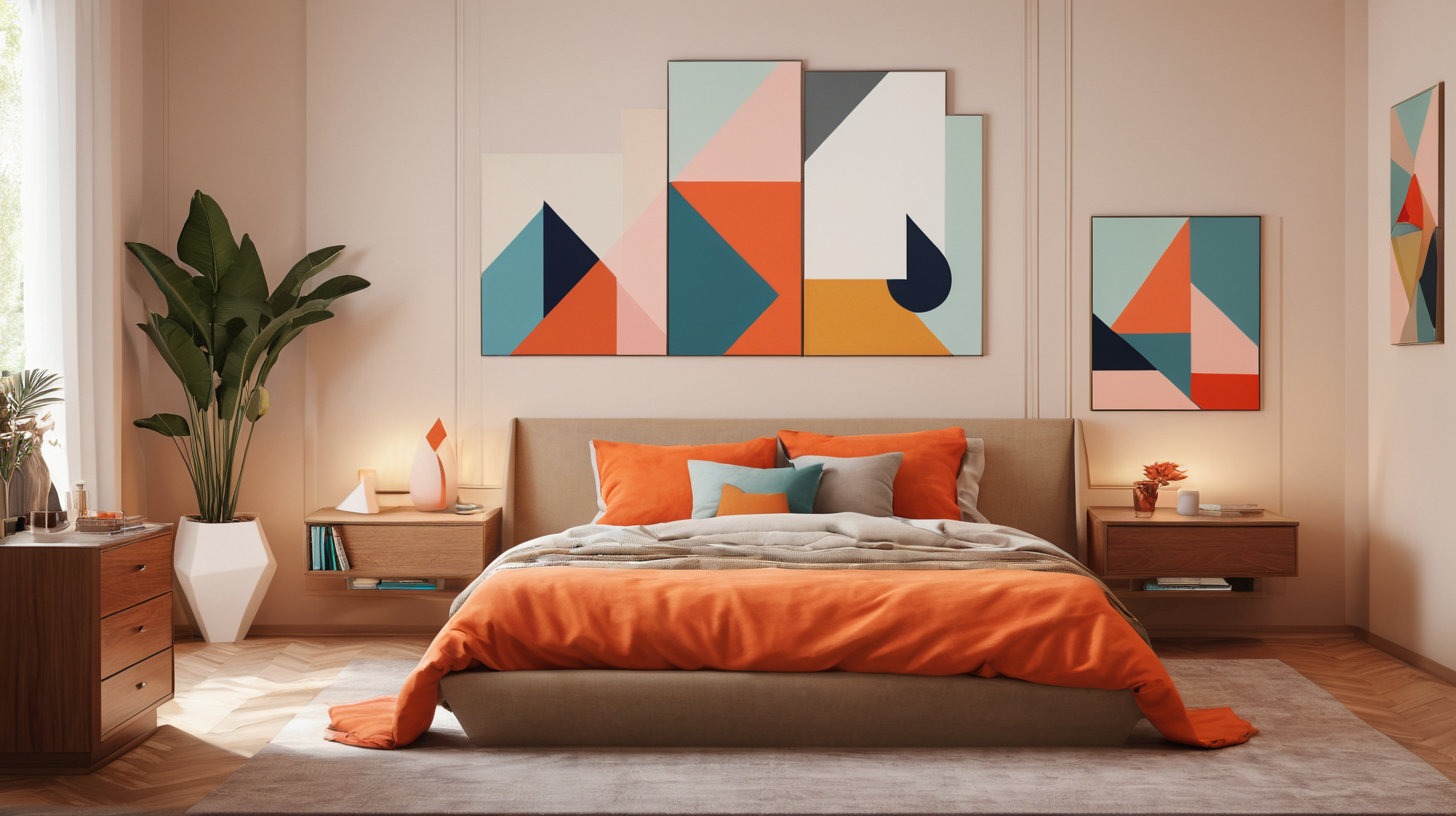
Have you ever wondered why some bedrooms feel instantly calming, while others leave you tossing and turning all night? The secret might be right on your walls! That’s right, folks – we’re diving into the fascinating world of bedroom colors and their impact on your mood and sleep. Trust me, by the end of this article, you’ll be eyeing your bedroom walls with newfound appreciation (or perhaps reaching for a paintbrush).
Let’s face it: we spend about a third of our lives in our bedrooms. That’s a lot of time surrounded by the same four walls. So why not make sure those walls are working in your favor? Whether you’re a night owl looking to catch more Z’s or just want to wake up on the right side of the bed, understanding the psychology of bedroom colors might just be your ticket to dreamland.
Key Takeaways:
• Bedroom colors can significantly influence your mood and sleep quality.
• Cool colors like blue and green are generally best for promoting relaxation and sleep.
• Warm colors like red and orange can be stimulating and may disrupt sleep patterns.
• Personal preference plays a crucial role in choosing the right bedroom color.
• Color psychology can be used to create a bedroom environment that supports your well-being.
The Science Behind Color Psychology: More Than Just Pretty Hues
Alright, let’s get our geek on for a moment. Color psychology isn’t just some new-age mumbo jumbo – it’s backed by some serious science. Our brains are wired to respond to color in ways that can affect our emotions, behavior, and even our physical state.
When light enters our eyes, it triggers a cascade of responses in our brain. Different wavelengths of light (which we perceive as different colors) can stimulate various parts of our brain, influencing everything from our heart rate to our hormone production. It’s like a silent symphony playing in our heads, conducted by the colors around us.
For instance, exposure to blue light can suppress melatonin production – that’s the hormone that helps us sleep. This is why sleep experts warn against using blue-light-emitting devices before bedtime. On the flip hand, warmer colors like red can increase our heart rate and blood pressure, making us feel more alert and energized.
But here’s the kicker: these effects aren’t just psychological. Studies have shown that color can influence our physiology too. In one experiment, participants in a blue room had lower blood pressure compared to those in a red room. Talk about the power of paint!
How Colors Affect Mood: A Rainbow of Emotions
Now that we’ve got the science down, let’s talk about how specific colors can turn your bedroom into an emotional palette. It’s like choosing between a lullaby and a rock concert for your eyes!
Warm Colors: The Life of the Party
Red: The Color of Passion (and Possibly Insomnia)
Red is like that friend who’s always up for a night out. It’s energizing, passionate, and can even increase your appetite (midnight snack, anyone?). But while it might be great for a dining room, it’s not exactly sleep’s best friend. A red bedroom might leave you feeling more wired than tired.
Yellow: Sunshine in a Can
Yellow is the color of happiness and positivity. It’s like waking up to a sunny day, every day. But be careful – too much yellow can be overstimulating. A soft, buttery yellow might work, but neon yellow? That’s a recipe for counting sheep all night.
Cool Colors: The Chill Squad
Blue: The Sleep Superstar
If colors were competing in a sleep Olympics, blue would take home the gold. It’s associated with calmness, serenity, and can even lower your blood pressure and heart rate. No wonder it’s the top choice for bedroom colors!
Green: Nature’s Lullaby
Green is like bringing a piece of the great outdoors into your bedroom. It promotes balance and relaxation, making it another excellent choice for catching those Z’s. Plus, it’s easy on the eyes – literally!
Purple: The Royal Treatment
Purple has long been associated with luxury and royalty. A deep purple can create a sense of coziness and comfort, perfect for drifting off to sleep. Just be careful with brighter shades – they might be too stimulating.
Impact of Bedroom Colors on Sleep: Painting Your Way to Better Rest
Now, let’s get down to the nitty-gritty of how these colors can affect your sleep. Because let’s face it, we’ve all had nights where we’d trade our kingdom for a good night’s rest!
Colors That Say “Sweet Dreams”
Blue: The Undisputed Champion
Remember how we said blue was the sleep superstar? Well, studies back this up. Participants in blue rooms have been found to sleep longer and more soundly than those in rooms of other colors. It’s like a lullaby for your eyes!
Green: A Close Second
Green isn’t just for your plants – it’s also great for your sleep! It creates a restful environment that can help you drift off to dreamland. Plus, it’s associated with nature, which can help reduce stress and anxiety.
Lavender: The Scent of Sleep
While technically a shade of purple, lavender deserves its own mention. Not only is it visually calming, but it’s also associated with the lavender plant, known for its sleep-inducing properties. Talk about a double whammy!
Colors to Avoid for Better Sleep
Red: The Insomnia Instigator
Remember how we said red increases heart rate and blood pressure? That’s not exactly what you want when you’re trying to wind down. Save the red for your Valentine’s Day decor, not your bedroom walls.
Orange: Too Much Energy
Orange is like red’s slightly calmer cousin. It’s still energizing and can increase brain activity – great for a home office, not so much for a bedroom.
Bright Yellow: Hello, Sunshine (At 3 AM)
While a soft yellow can be soothing, bright yellow is like having the sun shining in your face all night. Unless you’re aiming for perpetual daytime, maybe save this one for the kitchen.
Choosing the Right Color for Your Bedroom: Your Personal Sleep Sanctuary
Now, before you rush off to the paint store, let’s talk about how to choose the right color for your bedroom. It’s not just about slapping the “best” color on your walls – it’s about creating a space that works for you.
Factors to Consider:
1. Personal Preference: Do you feel relaxed in a sea of blue, or does it leave you feeling blue? Your personal taste matters!
2. Room Size: Lighter colors can make a small room feel larger, while darker colors can make a large room feel cozier.
3. Lighting: Natural and artificial lighting can change how a color looks. Always test your color in different lighting conditions.
Tips for Selecting Calming Colors:
• Start with a color you love and explore its softer shades.
• Consider the 60-30-10 rule: 60% dominant color, 30% secondary color, 10% accent color.
• Don’t forget about neutrals – they can be surprisingly soothing.
Color Combinations That Work:
• Soft blue with light gray accents
• Pale green with white trim
• Lavender with cream or beige
Remember, there’s no one-size-fits-all solution. Your bedroom should be your personal oasis, so choose colors that make you feel relaxed and happy.
Case Studies: Bedroom Color Transformations
Let’s look at some real-life examples of how bedroom color changes have impacted sleep and mood. These stories might just inspire your own colorful transformation!
The Blue Bedroom Bliss
Sarah, a marketing executive, was struggling with insomnia. Her bedroom was a vibrant red – great for her energetic personality, not so great for sleep. After repainting her room in a soft, powder blue, she noticed a dramatic improvement. “It’s like walking into a calm oasis after a hectic day,” Sarah says. “I’m falling asleep faster and waking up feeling more refreshed.”
The Green Dream
Mike, a teacher, wanted a bedroom that felt both relaxing and rejuvenating. He chose a sage green for his walls, complemented by natural wood furniture. “The green reminds me of being in nature,” Mike shares. “I feel more grounded and peaceful, which has definitely improved my sleep quality.”
The Lavender Lullaby
Emma, a new mom, was having trouble getting quality sleep between her baby’s feedings. She transformed her beige bedroom into a soft lavender haven. “The color is so soothing,” Emma says. “Even when I’m up at odd hours, the lavender helps me relax and fall back asleep more easily.”
DIY Tips for Painting Your Bedroom: Brush Up on Your Skills
Ready to take the plunge and give your bedroom a colorful makeover? Here’s a quick guide to get you started:
1. Prep Like a Pro: Clean walls, repair any damages, and use painter’s tape for clean edges.
2. Prime Time: Use a primer for better color payoff and longevity.
3. Choose Your Tools: Rollers for large areas, brushes for details and corners.
4. Paint in the Right Order: Start with the ceiling, then walls, then trim.
5. Take Your Time: Two thin coats are better than one thick coat.
6. Ventilate: Keep windows open for proper air circulation.
Remember, patience is key. Rome wasn’t painted in a day, and neither is a perfect bedroom!
Additional Ways to Enhance Your Bedroom Ambiance: Beyond the Walls
While the color of your walls sets the stage, there are other ways to create a sleep-friendly environment:
• Bedding: Choose colors and textures that complement your walls and feel cozy.
• Lighting: Opt for warm, dimmable lights to create a relaxing atmosphere.
• Natural Elements: Plants or nature-inspired decor can add a calming touch.
• Art: Select pieces that reinforce the mood you’re trying to create.
• Declutter: A tidy room can help calm a busy mind.
Remember, your bedroom should be a multi-sensory experience that promotes relaxation and good sleep.
FAQs: Your Burning Questions Answered
Q: What color is best for a bedroom to help sleep?
A: While blue is often cited as the best color for sleep, the best color for you depends on your personal preferences. Generally, cool colors like blue, green, and lavender are considered most conducive to sleep.
Q: Can bedroom color really affect my mood?
A: Absolutely! Color psychology is a well-studied field, and research shows that colors can indeed influence our emotions and behaviors. However, personal associations with colors can also play a significant role.
Q: How can I test a color before painting my entire bedroom?
A: Paint a large swatch (at least 2ft x 2ft) on your wall and observe it at different times of day. You can also use large poster boards painted with your chosen color and move them around the room.
Q: Are there any colors that can improve relationships?
A: While no color can magically fix relationship issues, some colors are associated with romance and intimacy. Soft pinks and purples can create a romantic atmosphere, while green is associated with balance and harmony.
Conclusion: Sweet Dreams Are Made of These
As we wrap up our colorful journey, remember that the perfect bedroom color is the one that makes you feel relaxed, happy, and ready for a good night’s sleep. Whether you’re team blue, green enthusiast, or part of the purple parade, the key is to create a space that feels like your personal sleep sanctuary.
So, why not give your bedroom a color makeover? You might just paint your way to better sleep and brighter mornings. After all, life’s too short for boring bedrooms and sleepless nights!
Ready to pick up that paintbrush? Sweet dreams are just a color away!




